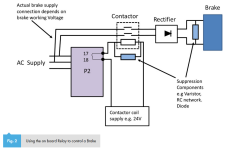I agree that the connection between the star points of motor windings and brake windings is unnecessary.
I am thinking that the unnecessary connection can cause current to flow between the output stage and line voltage (*). The drive possibly sees this as an earth fault.
*: Because the pulsed output is not 100% symmetrical over the 3 phases.
I am thinking that the unnecessary connection can cause current to flow between the output stage and line voltage (*). The drive possibly sees this as an earth fault.
*: Because the pulsed output is not 100% symmetrical over the 3 phases.







